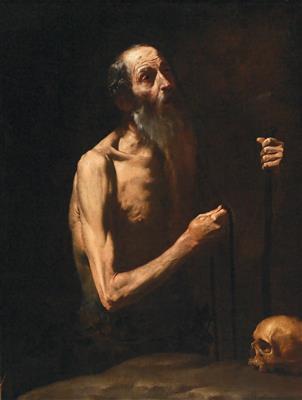Attributed to Jusepe de Ribera

(Játiva, Valencia 1591–1652 Naples)
Saint Onuphrius,
oil on canvas, 120 x 91.5 cm, framed
Provenance:
sale, Christie’s, London, 8 July 2005, lot 76 (as Circle of Jusepe de Ribera);
sale, Sothebys, London, 6 July 2017, lot 167 (as Studio of Jusepe de Ribera, called Lo Spagnoletto);
where acquired by the present owner
Ribera depicted Saint Onuphrius on a number of occasions and in various different compositions, including one in the Hermitage, St. Petersburg (inv. no. ГЭ375) and another, sold at Dorotheum, Vienna (25 April 2017, lot 72), depicting the Saint in an inverted position. A copy of the present painting, signed by the copyist Bartolomeo Bassente, was published by Perez Sanchez and Spinosa (see Ribera, L’opera complete del Ribera, Milan 1978, p.112, cat 118e) as a copy of a presumed lost original, before the present painting came to light. Following its revelatory cleaning in 2018, the present painting, which is the finest extant version of this specific Onophrius composition, would appear to be the hitherto lost original.
Jusepe de Ribera painted anchorite Saints like Onuphrius, Jerome, Anthony and Paul of Thebes on several occasions in compositions which usually repeated a similar scheme, with mystical figures emerging from the darkness of the background and accompanied by a few, and at times interchangeable elements, such as a skull. This subject was popular in the early seventeenth century, especially in Rome and Naples, and Ribera painted these works from the beginning of his career, as well as similar compositions depicting philosophers and apostles. As a painter in Rome in the early 1610s, Ribera was aware of the work of Caravaggio and he assimilated and re-elaborated the caravaggesque style. He moved to Naples in 1616.
Saint Onuphrius is here represented with great intensity and extreme realism. The Saint, who chose to live as a hermit in the desert, is painted holding a stick and a rosary and glancing upwards in prayer. His grey hair and beard and his emaciated torso reflect his life of struggle and deprivation. On the right of the compostion is a skull, a typical hermit’s symbol. Anatomical details are depictied with vibrant brush strokes, together with the rendering of intense light, creating an image of reality and extreme spirituality.
Professor Craig Felton has examined the present painting in the original and believes that it is a significant and fully autograph work by Jusepe de Ribera (private communication to the present owner).
30.04.2019 - 17:00
- Dosažená cena: **
-
EUR 68.557,-
- Odhadní cena:
-
EUR 50.000,- do EUR 70.000,-
Attributed to Jusepe de Ribera
(Játiva, Valencia 1591–1652 Naples)
Saint Onuphrius,
oil on canvas, 120 x 91.5 cm, framed
Provenance:
sale, Christie’s, London, 8 July 2005, lot 76 (as Circle of Jusepe de Ribera);
sale, Sothebys, London, 6 July 2017, lot 167 (as Studio of Jusepe de Ribera, called Lo Spagnoletto);
where acquired by the present owner
Ribera depicted Saint Onuphrius on a number of occasions and in various different compositions, including one in the Hermitage, St. Petersburg (inv. no. ГЭ375) and another, sold at Dorotheum, Vienna (25 April 2017, lot 72), depicting the Saint in an inverted position. A copy of the present painting, signed by the copyist Bartolomeo Bassente, was published by Perez Sanchez and Spinosa (see Ribera, L’opera complete del Ribera, Milan 1978, p.112, cat 118e) as a copy of a presumed lost original, before the present painting came to light. Following its revelatory cleaning in 2018, the present painting, which is the finest extant version of this specific Onophrius composition, would appear to be the hitherto lost original.
Jusepe de Ribera painted anchorite Saints like Onuphrius, Jerome, Anthony and Paul of Thebes on several occasions in compositions which usually repeated a similar scheme, with mystical figures emerging from the darkness of the background and accompanied by a few, and at times interchangeable elements, such as a skull. This subject was popular in the early seventeenth century, especially in Rome and Naples, and Ribera painted these works from the beginning of his career, as well as similar compositions depicting philosophers and apostles. As a painter in Rome in the early 1610s, Ribera was aware of the work of Caravaggio and he assimilated and re-elaborated the caravaggesque style. He moved to Naples in 1616.
Saint Onuphrius is here represented with great intensity and extreme realism. The Saint, who chose to live as a hermit in the desert, is painted holding a stick and a rosary and glancing upwards in prayer. His grey hair and beard and his emaciated torso reflect his life of struggle and deprivation. On the right of the compostion is a skull, a typical hermit’s symbol. Anatomical details are depictied with vibrant brush strokes, together with the rendering of intense light, creating an image of reality and extreme spirituality.
Professor Craig Felton has examined the present painting in the original and believes that it is a significant and fully autograph work by Jusepe de Ribera (private communication to the present owner).
|
Horká linka kupujících
Po-Pá: 10.00 - 17.00
old.masters@dorotheum.at +43 1 515 60 403 |
| Aukce: | Obrazy starých mistrů |
| Typ aukce: | Salónní aukce |
| Datum: | 30.04.2019 - 17:00 |
| Místo konání aukce: | Wien | Palais Dorotheum |
| Prohlídka: | 20.04. - 30.04.2019 |
** Kupní cena vč. poplatku kupujícího a DPH(Země dodání Rakousko)
Není již možné podávat příkazy ke koupi přes internet. Aukce se právě připravuje resp. byla již uskutečněna.
Další objekty umělce
-

Jusepe de Ribera, called lo Spagnoletto
Odhadní cena:
EUR 600.000,- do EUR 800.000,-
Všechny objekty umělce
